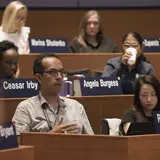Three Necessary Elements to Achieving Health Equity
Alicia Ferguson Hardy ’23, a Pozen-Commonwealth Fund Fellow in Health Equity Leadership and executive MBA student, discusses the takeaways from a recent panel discussion at the Yale Healthcare Conference.

I just completed my first year of the executive MBA program at Yale University as a Pozen-Commonwealth Fund Fellow in Health Equity Leadership. It’s been an incredible honor and challenge. I have learned so much and have gained incredible experience and insight that I have been able to bring to the team at OLE Health.
Recently, I was joined by several members of my cohort from the fellowship—Dr. Steven Starks, Fatimah Muhammad, and Dr. Mikah Owen—to participate in the Yale Healthcare Conference panel “Driving Health Equity: Perspectives from the Pozen-Commonwealth Fellowship,” a discussion moderated by Dr. Cece Calhoun ’21 on the most pressing topics in achieving health equity and mitigating disparities.
My portion of the panel focused on three main areas that I believe are necessary to achieving health equity:
- Access to care
- Advocacy and policy change
- Patient Engagement
Access to Care
Access to care is the most fundamental issue in our healthcare system today. Millions of Americans are uninsured, or live in rural geographic areas where healthcare is not readily available. Even in areas with access to care, many providers do not accept Medicaid, particularly for specialty care. We see this all the time at OLE Health as the only nonprofit health center in Napa County. We are often one of the few—if not the only—options for our communities. But access isn’t just about having providers or health centers that will accept the patient. The system is not designed to support individuals with transportation barriers, the inability to take time off work, or without access to broadband to engage in telehealth. We need to create true access for preventative and primary care that offers the services needed when and where and how our communities need them. At OLE Health, we offer appointments on the weekends or during evening hours and try to offer services and programs to alleviate transportation barriers, and we are constantly looking at how we can expand those offerings to meet the needs of our communities. Yet, we cannot achieve systemic change alone; that is where advocacy and policy change come in.
Advocacy and Policy Change
To advance real change, we need action from legislators. For those who work with vulnerable populations, we must do a better job of sharing stories with elected officials and decision-makers so that they can understand how policy affects our communities. We must also approach any potential policy solutions carefully and consider the ripple effect. Oftentimes, solving one problem in the healthcare system can create unintended consequences in another area. For example, consolidating pharmacy purchasing statewide in California reduced millions of dollars of revenue for Federally Qualified Health Centers, revenues that we use to offset the cost of providing uncompensated care to the uninsured or underinsured. Therefore, policy discussions should involve those who will be affected, and steps should be taken to mitigate potential negative impacts.
Patient Engagement
Empathy and connection are foundational to health wellness and healing, and no technology can replace the importance of human connection and relationships to engage patients in their care. Our systems, our workforce, our communities are strained, and our care teams are tired. We need to reenergize by providing that time to be in relationship and remember what we most value about being in healthcare. As we continue to see innovation and advancement in the healthcare space, and offer more virtual or hybrid options, this must continue to be a priority.
It was energizing to feel the engagement and passion in the room as we discussed equity topics ranging from mental health care for older adults, gun violence prevention, the criminal justice system and access to care for low-income and uninsured populations, and how our communities of color are disproportionately impacted. Inequities are pervasive, and racism within our system must be addressed on a structural level so that all can enjoy the highest possible quality of life. I am grateful to all those who had a hand in organizing the Yale Healthcare Conference, with a broad focus on humanizing healthcare through patient-centered innovation. These are complex, but critical conversations, and we must continue to develop solutions together.



